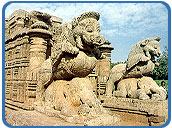INDIAN
TRAVEL GUIDE
Eastern
India Travel Guide
 DARJEELING
DARJEELING
Darjeeling, world famous for its teas, is nestied in a setting of Kanchenjunga
and Mount Everest, Tibetan Monasteries, Himalayan Tribal Life, Pine Trees etc.
Which make her qualify as the queen of the hill stations.
Places to see:-Tiger Hill- 11 kms. 8482 ft./2590 mtrs; Ghoom Monastery- 8 kms;
Batasia Loop- 5 kms; Himalayan Mountaineering Institute- 2 kms. 0830-1300 &
1400-1630 hours; Himalayan Zoological Park; Darjeeling Rangeet Valley Passenger
Ropeway- 8 kmslong ropeway.
BHUBANESHWAR
The ancient capital of the Kalinga empire, and now the capital of Orissa, Bhubaneswar's
history goes back over 2000 years. "Bhubaneshwar" means the "abode
of God" or "master of the universe" and it was also, once known
as the 'Cathedral of the East', on account of the large number of shrines. At
one time, the Bindu Sagar tank was bordered by over 7000 temples. Of these,
500 still survive, all built in the extravagant Oriya style. It is of these
temples, that the great poet, Rabindranath Tagore had once said - 'At all places
where the eye rests, and also at places where the eye does not rest, the busy
chisel of the artist has worked incessantly. The abode of god has been enveloped
by a variety of figures depicting the good and the evil, the great as well as
the insignificant, the daily occurences of human life....'
GANGTOK
Perched atop a ridge at a height of 1520 mts. Lies Gangtok, a tantalizing town
touched by a panorama of colours. Gangtok the capital of Sikkim, is today a
busy town bustling with hectic activity.
Its captivating architectural beauty radiates with pagoda-like wooden houses,
painted turquoise roofs and gay bazaars. Undoubtedly modern times have wound
their way into this picturesque town, but the gently swaying and elegant costumes
of the Sikkimese people, their smiling faces, the unhurried pace of their life-style
and the towering beauty of Kanchenjunga ..... all cast a magic spell on this
delightful location in the foothills of the grand Himalayas.
 KONARK
KONARK
The crowning glory of Oriya temple architecture, the 13th century Sun temple
also known as ' the Black Pagoda', comes with a baggage of centuries - old myths
and legends. Legends say that Samba, the son of Lord Krishna, was afflicted
by leprosy, brought about by his father's curse on him. After 12 years of penance,
he was cured by Surya, the Sun God, in whose honour he built this temple .
Those interested in attending the Konark Dance Festival, held in the Open air
Auditorium north of the Sun Temple, should visit during the first week of December.
GUWAHATI
Guwahati has several places of historical interest. Perhaps the biggest attraction
is the Kamakhya Temple atop Nilachal hill, where the Goddess Kamakhya is worshipped
and which commands a majestic view of the city and the river. The ponds here
are home to giant turtles which are quite Used to being fed by visitors. Another
temple which draws people is the Shiva temple on the island. There other centres
of religious and archeological interest such as the temples of Nabagraha and
Basista as well as of Janardhana.
IMPHAL
Imphal a mini-metropolis the capital of this beautiful land of blue-green hills,
cascading rapids, carpets of flowers and winding rivers beckons the tourist.
It is connected by road with Guwahati (Assam) through National Highway No.53.
Here the Govindajee Temple is a prominent Vaishnavite centre. The simple aesthetic
structure has two golden domes and a large performed on special occasions. The
shrine of Vishnu is flamked by shrines of Krishana & Bal Ram on one side
and Jagannth on the other. In the heart of the city are two memorials, the towering
Shaheed Minar in Tikendeajit Park that commemorates the mirtyrs who died fighting
British Colonilism and the war cemetery that revives the memories of those British
and Indian soldiers who led down there lives during the second world war, which
came to the doorstep of Imphal.








 DARJEELING
DARJEELING
 KONARK
KONARK